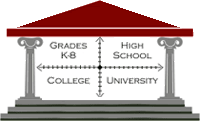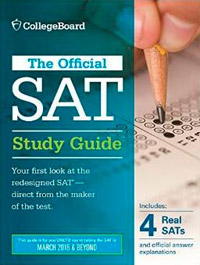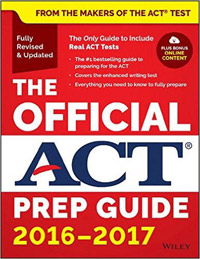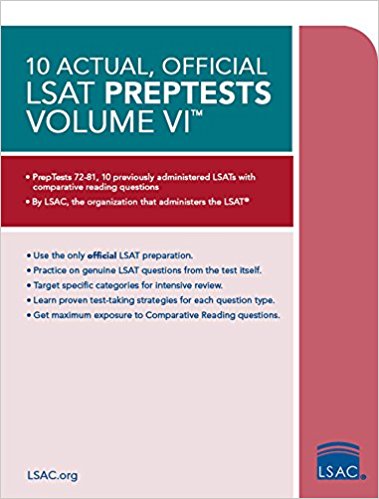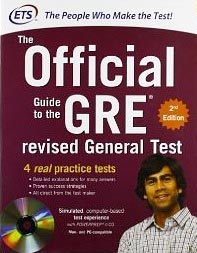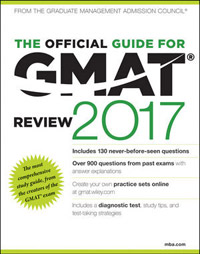|

Did you know that in order to become a National Merit Scholar Finalist, you must not only score high enough on the PSAT Selection Index to reach or exceed the semifinalist cutoff for your state, but you must also achieve what’s called a “confirming score” on the SAT or ACT? Although this requirement is mentioned in the guide to the PSAT/NMSQT published by the National Merit Scholarship Corporation, nowhere in the official materials or NMSC website does it specifically indicate how one's confirming score is calculated.
Well, after some extensive internet research (and finally, a phone call to the NMSC just to verify what I had gleaned from third-party sources, since the NMSC's official written materials are non-specific), I’ve determined the exact methodology for converting an SAT or ACT score to a confirming score.
A confirming score is simply an SAT or ACT score with a Selection Index that is equal to, or higher than, the national commended cutoff, which is the same each year regardless of state (the commended cutoff, which can change from year to year, is currently 209 for the class of 2021). Practically speaking, this means that anyone who qualifies as a National Merit Scholarship semifinalist (PSAT scores of 1400/1520 and up, depending on the state of residence) should be able to easily achieve a confirming score (SAT scores as low as 1320/1600, and ACT scores as low as 26/36), especially given multiple attempts.
So, why is converting an SAT score to a confirming score Selection Index so much more forgiving than converting a PSAT score to the PSAT Selection Index? Since the SAT has 1600 points per test and the PSAT only 1520, there are a total of 240 Selection Index points available on the SAT, versus only 228 on the PSAT (for some reason the College Board does not adjust the scores to account for this difference, which works in your favor). In addition, the confirming score only requires that you meet or exceed the "commended" cutoff, which is always the lowest bar of them all, and is most likely easier than becoming a semifinalist in your state.
UPDATE: While the NMSC apparently does put an upper limit of 228 on any Selection Index scores earned on the SAT, all this means is that SAT SI scores of 229-240 are officially counted as a 228 Selection Index, which makes no meaningful difference at all.
The Selection Index can be determined by taking your Reading/Writing score on the PSAT or SAT, dividing it by 10, then multiplying that answer by 2. Then, divide your Math score by 10, and add that answer to the previous result.
Another way to think of it is (Math score out of 760) + 2(Verbal score out of 760), and then remove the zero at the end. For example, a perfect 1520 PSAT score would be 760 Math + 2 (760 Verbal) = 2280 = 228 Selection Index.
Converting an ACT score to a Selection Index (SI) is a little trickier, but it can be done. First, throw out the Science score entirely, since the SAT doesn’t have a comparable section. Then, convert the ACT English + Reading score to the SAT Evidence-Based Reading and Writing (ERW) score using Table C2 of the official SAT / ACT concordance tables published by the College Board and ACT, Inc.. Do the same with the ACT math score using Table B2, then add the scores together using the same procedure outlined in the paragraphs above, giving the verbal score twice the weight as the math score.
Of course, in order to become a National Merit finalist, you must first become a semifinalist by meeting or exceeding the state-by-state cutoffs on the PSAT/NMSQT, which is the (much!) tougher task because you only get one try, and there are fewer SI points available (228). Below are those cutoffs for the Class of 2021.
The highest Selection Index cutoff (222): Massachusetts, New Jersey, Washington DC.
The lowest Selection Index cutoff (209): North Dakota, South Dakota, West Virginia, Wyoming, US Territories
Alabama 212
Alaska 212
Arizona 218
Arkansas 212
California 221
Colorado 217
Connecticut 220
Delaware 219
District of Columbia 222
Florida 216
Georgia 219
Hawaii 217
Idaho 214
Illinois 219
Indiana 215
Iowa 212
Kansas 214
Kentucky 214
Louisiana 212
Maine 213
Maryland 221
Massachusetts 222
Michigan 216
Minnesota 218
Mississippi 211
Missouri 214
Montana 210
Nebraska 213
Nevada 215
New Hampshire 215
New Jersey 222
New Mexico 211
New York 220
North Carolina 217
North Dakota 209
Ohio 215
Oklahoma 211
Oregon 217
Pennsylvania 217
Rhode Island 216
South Carolina 212
South Dakota 209
Tennessee 215
Texas 219
Utah 212
Vermont 212
Virginia 221
Washington 220
West Virginia 209
Wisconsin 213
Wyoming 209
U.S. Abroad 222
U.S. Territories 209
UPDATE, 12/9/19: According to the NMSC website, it is possible to qualify for the NMSQT even if you miss your scheduled PSAT administration, by writing to the NMSC and asking to instead take the SAT as your NMSQT make-up test. Again, this presents a huge opportunity and an obvious loophole, since 1) the SAT has more available SI points than the PSAT, and 2) on the SAT you are given multiple attempts:
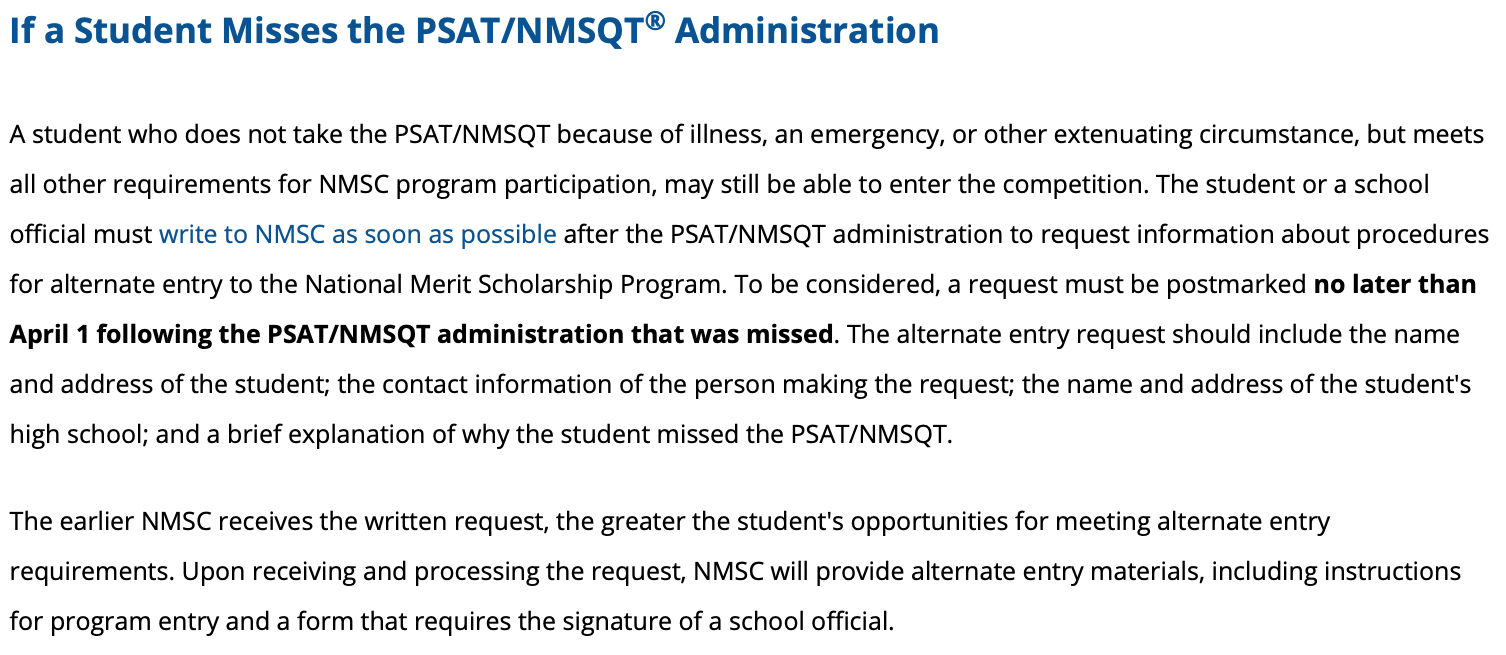
Please note that the conversion method to a Selection Index is different for National Merit Qualifying Test purposes than it is for confirming score purposes. Since the PSAT is out of 1520 points, the maximum raw score you can earn on any section of the SAT is capped at 38 (or, if it's easier, the maximum Verbal and Math scores are capped at 760 instead of 800). This means that any section scores above 760 in the SAT are irrelevant for NMSQT Selection Indices. In other words, although these points are helpful for your confirming score SI, they cannot be "banked" or used toward your Selection Index for National Merit Semifinalist qualifying purposes.
Is it weird that there are two different ways of calculating a Selection Index from the same SAT score? Yes, yes it is...but the College Board is known for this type of nonsense. It's just my job to stay on top of it all.
For more, please see this official "Alternate Entry to the 2021 National Merit Scholarship Competition" document and application form.
Back to Blog Home
|



